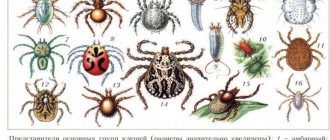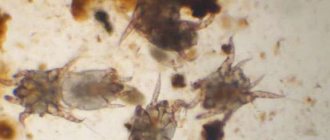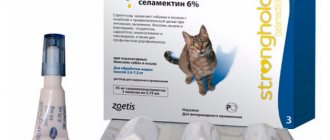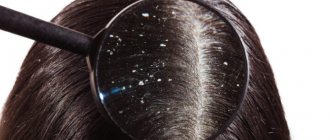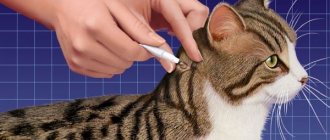The first signs and symptoms of infection
The first clutch of eggs occurs on the scalp. Scabies in cats manifests itself as thickening of the damaged areas and the formation of crusts. First of all, the back of the nose, the lower part of the ears and the brow ridges are affected. The resulting wounds take a long time to heal and cause constant discomfort to the pet. He becomes restless and irritable, sleeps poorly, refuses to play and eat. As the disease progresses, behavioral changes are complemented by more obvious signs. These include:
- constant itching and head shaking;
- extensive loss of hair on the head, ears, belly and paws;
- growth of lesions to the formation of bald spots and bald spots;
- swollen lymph nodes;
- the appearance of a nodular rash with thick, colorless or white contents;
- redness and suppuration of damaged skin, causing severe pain when touched;
- the formation of crusts and scales at the site of healing of ruptured papules.
Every owner should know what scabies looks like in cats in order to promptly help their pet if infected. If you notice one of the listed signs, contact a veterinary clinic for further diagnosis.
The first signs of scabies in a cat
Before the main signs appear in the animal, indirect symptoms of the disorder can be noticed. Mite reproduction begins from the scalp. Typically, the manifestation of the parasite can be seen at the bottom of the ears, above the eyes and on the bridge of the nose. The epidermis in these areas begins to thicken, becomes unpleasant to look and feel, and may become covered with purulent crusts. Wounds take a long time to heal and cause discomfort to the pet.
Periodic examination of your pet's ears will be a reliable prevention of ear parasites.
The cat's behavior is marked by anxiety and irritability. The pet constantly tries to scratch the sore spot, stops eating and playing normally. Because of this, the cat’s appearance begins to suffer and its body weight decreases. Taking into account the deterioration of the sick animal's condition, other signs of scabies appear.
In later stages, the disease is easily recognized by the characteristic behavior of the cat.
Division into types depending on the pathogen
Symptoms and treatment for mange in cats depend on the type of mite. According to this criterion, 4 types of disease are distinguished.
Otodectosis
The causative agent is the tiny ear mite Otodectes cynotis. The maximum size of its body is only 0.75 mm. It affects the outer and inner parts of the ear. Distinctive signs of otodectosis are severe ear itching, the appearance of a nauseating smell of rot and dark grains inside the ears. An infected cat constantly shakes its head and rubs its ears against any objects.
Demodicosis
Demodex canis is a cigar-shaped parasite that is light gray in color. The length of its body is 0.2-0.3 mm. Unlike other pathogens, it lives in the sebaceous glands and hair follicles from the moment the animal is born. The development of demodicosis occurs with a sharp drop in immunity.
According to the degree of damage, there are 2 forms: localized and generalized. In the first case, the diameter of the lesions is no more than 2.5 cm, in the second, the disease affects most of the body. The localized form often goes away on its own and responds well to drug therapy. The chance of recovery from chronic demodicosis depends on the complications that arise. When a secondary infection occurs, they drop to 50%.
Depending on the symptoms, demodicosis can be scaly or pustular. In the first case, redness and cracking of the skin is noted, in the second - the appearance of suppuration and ulcers. The danger of generalized demodicosis is in the combination of scaly and pustular forms. The disease is accompanied by severe complications and is difficult to treat.
Sarcoptic mange
Sarcoptes scabiei is a broad-oval tick that is white-yellow or completely white. The length of the smallest representatives is 0.14 mm. They affect the entire surface of the body and cause sarcoptic mange. You can suspect their appearance by thin light gray lines with a small bubble at the end that appear on the affected areas.
Notoedrosis
Notoedres is a round, dirty gray parasite. The length of its body is 0.5-0.45 mm. Most often it affects the outer side of the ears. In this case, dark gray discharge with a foul odor appears from the ears. Due to liquid secretions, the fur sticks together and takes on an unkempt appearance. The disease is called pruritic scabies, or notoedrosis.
Treatment of sarcoptic mange in cats
A severe form of the disease, which quickly provokes a deterioration in the pet’s condition. After contact with the skin, the mite gnaws small passages in the epidermis, where it can place up to five dozen eggs.
Sarcoptic mange poses the greatest threat to pet health due to the extreme activity of the mite
Within a few days they reach the larval stage, and after two weeks they can lay new offspring. The animal constantly suffers from itching, due to which it can die within a few weeks. Treatment uses one of the medications described below or a combination of them.
Stronghold
To eliminate sarcoptic mange, you should take a 6% concentrate. It is used on kittens and adult cats over 2.5 months of age. If the cat weighs less than 2.5 kg, the dose of the solution is 0.25 ml; for larger weights, dosages of 0.75 ml of concentrate are used.
Drops of Stronghold
The active substance must be applied strictly to healthy skin, choosing an area closer to the base of the neck. Taking into account the pet’s condition, the treatment is repeated after 2-4 weeks.
Levomekol
An antibacterial ointment that protects your pet from secondary infection and allows the skin to heal and remove inflamed and purulent areas. Levomekol should be applied to the affected areas in a small layer.
Levomekol effectively fights microbes and heals complex wounds
If large areas of skin are affected, you need to spread the ointment over a bandage and fix it on the animal. Shoot daily. Antibacterial ointment against scabies should be used for 5-10 days.
Butox
Available in small capsules for preparing a bathing solution. To eliminate scabies, you need to use a type of drug Butox 50. The dosage of the medication, regardless of the age and condition of the animal, is 1 ml per liter of warm water.
Butox in ampoules
The resulting emulsion should be used to thoroughly bathe the sick animal. Repeated treatment is carried out after a week. If it is difficult to bathe your pet or there are no conditions for this, you can spray the solution over the fur and skin. The dose of the active substance and the number of repeated applications do not change with this treatment.
Demos
It is also prescribed for the treatment of demodicosis and notohedrosis, and is available in the form of liniment. It is necessary to apply the drug using a cotton swab at the rate of 0.1-0.3 cm3 per 1 kg. For severe lesions, the treatment is repeated every other day.
Demos copes well with various types of parasites, but it is not recommended to apply it to extensive wounds
If the pet's condition is relatively normal, repeated treatments are done at intervals of five days 2-3 times. Do not use on very young kittens or nursing cats.
Attention! Butox 50 shows a good effect against scabies mites of any type. But it is strictly not recommended for use on large open wounds.
Can a person get infected from a cat?
Scabies mites in cats are contagious, but not dangerous to humans. In rare cases, otodectes cynotis causes otitis externa. Sarcoptic mites or notohedrosis mites can cause itching or other allergic reactions, but they leave human skin on their own within a month - it is too dense for them. Parasites are not able to gnaw tunnels in it and lay eggs. However, scabies in humans manifests itself in the form of severe itching and causes significant discomfort.
Demodex canis lives in the deeper layers of the epidermis of cats and dogs. It dies upon contact with human skin.
Despite the absence of serious complications, it is recommended to use protective gloves when treating your pet and wash your hands thoroughly after each procedure. To kill ticks from personal items (clothing, bedding), you will have to boil them. The area where the sick animal lives is regularly vacuumed, and the floors are washed with a disinfectant.
Elimination of demodicosis mites in cats
Typically, this pathogen does not cause any serious problems and rarely requires treatment with medication. But if severe itching occurs, you should definitely show the animal to a doctor. Depending on the intensity of your symptoms, one of the medications described below will be prescribed.
Cats usually tolerate demodicosis easily.
Aversectin ointment
Effective against subcutaneous scabies mites; with early detection, 1-2 uses are sufficient. Apply the ointment in a small layer using a brush or your hands. The active substance is rubbed against the growth of the hair.
Aversectin ointment for cats
You cannot use more than 0.3 g of Aversectin per 1 square meter. cm of cat skin. Taking into account the complexity of the pet’s condition, the epidermis should be treated twice with an interval of 5 days, three times every 7 days, or seven times also with a week’s break between rubbing.
Neostomazan
Available in the form of a 2 ml solution. For treatment, the emulsion must be dissolved in 400 ml of warm water. After thoroughly stirring the concentrate, apply it to the entire skin and fur of the cat, avoiding contact with the eyes, mouth and nose.
Neostomazan concentrate
Be sure to carefully treat the face using a cotton pad or swab. Repeated treatment is carried out after a week. Until the animal is dry, it should not be allowed to come into contact with household members and objects.
Tsipam
An oil solution for external use to relieve irritation and dry skin. To eliminate the unpleasant symptoms and activity of the demodectic mite, you need to step back 2-4 cm from the animal’s head and apply the medication to the skin in a thin stream.
Tsipam ear drops
It is important to spread the fur well so that the active substance penetrates as deeply as possible into the layers of the epidermis. After 15 minutes, the cat is combed with a comb according to the growth of the fur to distribute Tsipam. Repeated treatment is carried out after a week.
In addition to demodicosis mites, tsipam also effectively fights ear infections.
Attention! The drug Neostomazan can be used to treat ear mites. Dilute it in the same way and instill 3 drops into each ear. The treatment is also repeated twice at weekly intervals.
Causes of the disease and its consequences
Scabies mites feed on lymph and blood. They gnaw through the upper layers of the epidermis and lay eggs there. Due to activity in the scabies tracts, the infected person develops severe itching. Constant scratching leads to hair loss and the appearance of suppuration. The eggs laid quickly develop into adults, so if untreated, mange in cats covers the entire body.
Infection with parasites occurs in 3 ways:
- Direct contact with sick animals. The carrier may be another cat, dog or bird. In urban areas, the most common bird carrier is the pigeon. Even pets are not insured, since contact can occur at a veterinarian's appointment, on public transport or at an exhibition. Kittens are especially vulnerable because they can become infected from a sick mother.
- Interacting with the personal belongings of an infected person. If you keep several pets, everyone will become infected.
- Transfer of pathogens on shoes or clothing. You can bring parasites into your home after your next walk. There is no way to protect yourself from this.
The only exception is demodex canis. This type of scabies in cats is directly related to the immune system.
A sharp weakening of the body and the development of demodicosis occurs in the presence of the following factors:
- pregnancy and childbirth;
- diseases of the endocrine system (hypothyroidism, Itsenko-Cushing's disease);
- helminthiases;
- hypothermia;
- autoimmune pathologies (lupus, pemphigus);
- oncology;
- long-term use of antibacterial drugs;
- poor nutrition;
- infectious diseases (for example, plague);
- allergic reactions;
- mental disorders and stress;
- estrus;
- dermatological diseases;
- change of teeth;
- unsuitable climatic conditions;
- surgical operations.
The risk group includes kittens, elderly cats and animals with chronic pathologies. What they all have in common is low immunity, unable to fight back the parasite that has entered the body.
Without timely treatment, a cat's scabies spreads throughout the body and causes complications in the internal organs and systems. The kidneys, spleen, stomach, liver and lymph nodes are affected. With advanced otodectosis affecting the inner ear, the likelihood of damage to the meninges increases. No less dangerous are ulcers that attract pathogenic microorganisms. When a secondary infection occurs and the immune system is weakened, the patient dies from blood poisoning.
The main causes of mange in cats
In addition to the direct impact of the parasite on the skin, other factors can also provoke disorders. The pathogen can remain on the skin of an infected animal for a long time without showing any signs or symptoms.
Parasites may not show any signs of life for a long time until the pet’s body gives up.
But in the presence of special provoking factors, the disease begins to manifest itself and becomes dangerous. These causes of scabies include:
- damage to the skin;
- skin diseases of any type;
- decreased immunity due to lack of nutrients;
- decreased immunity due to the presence or course of therapy for any disease;
- young age of the cat;
- predisposition to infection due to belonging to a specific breed;
- constant contact with infected animals.
At risk are individuals whose immunity is weakened for various reasons.
Attention! Most often, scabies appears in kittens and pets who have not yet reached two years of age. Pregnant and lactating individuals are also at risk due to reduced immunity. These groups of pets require special care, control and prevention.
Diagnosis and treatment
If alarming symptoms are detected, you should contact a veterinary clinic. After a thorough examination, the doctor will identify the pathogen and tell you how to treat scabies in a cat.
Making a diagnosis and prescribing medications
During diagnosis, the veterinarian collects anamnesis and conducts an external examination of the caudate patient. To determine the pathogen, microscopic examination of skin scrapings is used. This allows you to exclude diseases with similar symptoms: dermatitis, lichen, eczema and allergies.
The duration of drug therapy depends on the condition of the cat and the degree of skin damage. On average, its duration is 1-3 weeks. The drugs used are divided into injection (solutions for intramuscular and intravenous injections) and external (ointments, medicated shampoos, drops).
How to treat scabies mites in a cat directly depends on the diagnosis. The list of required medications includes:
- antiseptics (chlorhexidine, hydrogen peroxide) used to clean the affected surface;
- acaricides aimed at combating ticks;
- antibiotics that destroy secondary infections;
- antihistamines, relieving itching and irritation;
- immunomodulators and vitamin complexes that stimulate the functioning of immune cells.
The main emphasis is on antiparasitic treatment. The choice of drug is individual. All dosages are determined by the doctor. The most popular acaricidal agents include:
1. Amitrazine
. Solution for external use with a cumulative effect. It treats scabies mites in cats of all types and forms, relieves pain and softens the skin. Amitrazine is applied 2-5 times a day with a mandatory break of a week. This scheme helps maintain immunity against the pathogen after use.
2. Ivermectin
. An injection solution that affects all types of scabies mites. The period of its use is only 7 days. Due to the rather aggressive effects on the body, it is important to strictly follow the recommended dosages. Ivermectin is not suitable for kittens.
3. Sulfur ointment
. An inexpensive and accessible product that destroys larvae and adults. The ointment has no direct effect on laid eggs. Their destruction is possible only after hatching, so the duration of treatment is maximum. The treatment is carried out 2 times a day, applying a thin layer of ointment to the affected areas.
4. Aversectin ointment
. Another drug that affects all forms of the pathogen. The dosage regimen is similar to Amitrazine. To apply the ointment, use a special spatula.
5. Lawyer
. Single-use drops are suitable for controlling ticks, helminths and fleas.
The effectiveness of therapy depends on the regularity of the recommended procedures. Even a single missed application of a remedy can delay recovery for an unknown period.
How to care for an animal at home
After diagnosis, it is necessary to isolate the patient from people and other pets. Boil, treat with special means or take out into the cold all things that the sick cat has come into contact with.
Before treating with medicinal products, wash the infected animal with veterinary shampoo. This is necessary to get rid of dead epidermis, fallen hairs and dried blood. The hair on the affected areas is cut off after drying. This facilitates subsequent treatment with ointments and solutions. It is recommended to ensure that you have a protective collar in advance. It will protect against licking off medications and new damage.
To clean the ears, use cotton pads soaked in sunflower oil or plain water. After treating all affected areas, follow your veterinarian's instructions. Remember that using cotton swabs is dangerous: they can injure the eardrum and damage your furry pet’s hearing. It is also prohibited to apply several drugs at the same time. This may lead to an allergic reaction or other side effects. To be safe, take 15-minute breaks.
In consultation with a veterinarian, the use of folk remedies is permissible. They are easy to prepare at home. Before use, be sure to test a small amount of the product on your skin to rule out an allergic reaction. Popular folk remedies include:
- Sulfur soap
. It is used once during the first bath. Sulfur has antifungal and antibacterial properties.
- White vinegar
. Spray the coat with vinegar solution twice a day for 2 weeks. Avoid contact with open wounds. Vinegar is very irritating to the skin.
- Bay leaf
. Grind the bay leaf along with the melted butter in a blender. Apply the resulting ointment to the wounds twice a day for 1-2 weeks.
- Essential oils
. To relieve swelling and irritation, rub a few drops of lavender or almond oil into the affected areas. Repeat the procedure twice a day for 2-3 weeks wearing protective gloves.
- Boric acid
. Treat the affected ears with the solution every week until complete recovery.
- Buckthorn bark
. Grind 2 tbsp. l. leaves and pour a glass of boiling water. Keep the solution in a water bath for 15 minutes, then strain and cool to room temperature. Rub the resulting solution into your skin twice a day for 2 weeks.
When using the listed products, avoid contact with mucous membranes. This can cause severe burning or burns.
Remember that during home quarantine all pets will need diagnostics. If the diagnosis is positive, they are prescribed similar treatment; if the diagnosis is negative, the use of acaricidal collars and drops on the withers will be sufficient.
It must be remembered that treatment of scabies in cats at home should be carried out strictly according to the regimen prescribed by the veterinarian. In addition, it will not be possible to carry out the therapy completely on your own - to determine recovery, you will need to take a scraping and analyze it. Such diagnostics are only possible in a clinic.
Diagnosis of disease in cats
Scabies has similar symptoms and manifestations to dermatitis and ringworm, so you should not make a diagnosis yourself. To clarify the condition of the animal and identify the type of tick, a routine examination by a veterinarian is first carried out, after which materials are sent for laboratory testing.
If you suspect scabies, give preference to laboratory tests rather than self-diagnosis
To do this, using a sterile scalpel, the doctor removes scrapings from the diseased area of the epidermis onto a special glass and packages it. It is recommended to examine the deepest layers of skin possible to find traces of the parasite. Under a microscope, the veterinarian will be able to view the biomaterials, after which he will confirm or refute the diagnosis.
The deeper the layer can be taken for analysis, the higher the likelihood of identifying the irritant.
Attention! Diagnosis is always carried out the same way for all types of scabies mites, including the rare form of sarcoptic mange. The difference lies only in the treatment that the doctor selects, taking into account the final diagnosis and the presence of concomitant disorders.
Treatment of notoedrosis in cats
The most dangerous form of the disease for cats. Often requires the use of injections to suppress mite activity and prevent its reproduction. Notoedros is extremely dangerous for other animals and humans, so during the treatment period the pet should be in maximum isolation. To eliminate this type of scabies, the most powerful and fast-acting medications are prescribed.
Notoedrosis requires rapid response and immediate treatment
Aversect
The drug is a 1% solution for subcutaneous administration, most often prescribed in advanced cases of scabies. The dosage of the active substance is 0.2 ml per 10 kg of weight; more precisely, the dose is calculated taking into account the weight of a particular cat.
Despite the manufacturer's assurances, Aversect often causes side effects in animals
The active substance must be administered twice with a break of five days. The drug often causes severe side effects and can only be used under medical supervision.
Amit
A good anti-scabies remedy that does not overdose and rarely causes side effects. The dose is 0.5 ml per kilogram of weight. Used externally. Apply the product carefully, starting from the back.
Ascaricidal drug Amit forte
Capturing a little healthy skin where traces of infection may still be invisible. Repeated treatments are carried out after 5-7 days from two to five times, taking into account the health status of the sick animal.
Chlorhexidine
Used for external treatment of inflamed areas and skin disinfection, has a moderate antipruritic effect. Chlorhexidine can be used 2-3 times a day for 10 days.
The substance should not be applied to healthy skin, as it causes severe drying.
Chlorophos solution or aqueous emulsion of nicochloran
Both drugs show the same effectiveness against scabies mites. When using chlorophos, you should take a 2% concentrate; when prescribing an aqueous emulsion of nicochloran, use a 5% concentrate.
After rubbing the medicine in, do not lick it under any circumstances, otherwise serious poisoning will occur.
These substances are good for wiping the skin and fur of a sick animal. The solutions are used twice with a break of 6-8 days. They help well with advanced stages of notoedrosis.
Attention! For notoedrosis, veterinarians recommend bathing your cat daily to remove scales and relieve irritation. But not every individual tolerates such procedures well, which can become additional stress for it and lead to a state of shock.



